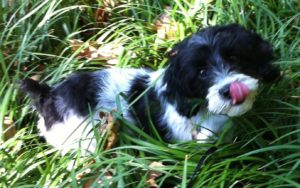
Dogs don’t speak English, but they are extremely good communicators. They show us how they’re feeling through their body language – though we often miss the signals. Eyes, ears, tail, hair, posture, and behaviors all are indicators of a dog’s mood and feelings. Do you know what it means when a dog tucks his tail or his ears back? He’s a little fearful about what’s happening. That was an easy one. Let’s try some that are a little harder. Take this quick quiz to see how well you speak “dog.” Give yourself one point for each correct answer:
- Stares at you with a direct gaze
- Leans forward
- Licks his lips (when not thirsty)
- Holds or wags his tail vertically
- Sneezes (when not sick)
- Yawns (when not tired)
- Pants (when not hot)
- Freezes momentarily
- Shows his teeth
- Wags his tail in big loopy circles
- Sniffs the ground suddenly, when there is nothing there
- You can see the white of the dog’s eye (“whale eye” or “half-moon eye”)
Answers
- The dog is uncertain and is making a decision about what to do. It usually means he’s agitated and thinking about jumping toward you.
- He is ready to interact with you. If he is stiff or growly, or his mouth is tight or his hackles are up, he may be ready to lunge. If he has a relaxed, open mouth and soft eyes, he may want to play.
- He’s a little anxious and would like more space.
- A vertical tail is a strong warning, even if it is wagging – he’s ready to aggress. Not all wags are happy! Do not engage with the dog. Back off gently.
- He’s excited and may be happy. This is a behavior seen during play with favored people.
- He’s a little nervous and intimidated and would appreciate more distance from whatever is going on.
- He’s anxious.
- He’s anxious and making a decision about whether to fight or flee. If you see this, you should avert your gaze and calmly back off.
- This is a trick question. If the dog’s mouth is loose and his tongue is hanging out, he may be very relaxed. BUT, if his mouth is tight with the lips pursed, he is thinking about taking matters into his own paws. Avoid a dog who demonstrates this behavior. He may be ready to lunge. Back off gently, and DO NOT STARE at or touch him.
- He’s happy and calm.
- He’s a little anxious and wishes he could avoid the situation around him. Give him more space, and don’t make him continue with the activity around him.
- This dog wants to be left alone. He is frightened. Are the kids mauling him when he does this? Stop them, and teach proper safety and kindness around dogs. Here are some great posters for kids, by Lily Chin. They’re free and sharable if you follow the terms of this license.
Scoring
9-12 correct answers: You’re a pro. Keep observing the dogs in your life and help others understand what they’re looking at. You’ll be doing the people and dogs a favor. 5-8 correct answers: You’re pretty observant but you could use some practice. Check here, here and here for helpful information and examples. 0-3 correct answers: WOOF! Start studying. By learning more, not only will you and your family be safer, you’ll also earn the trust of your best friend.
For more information on these body language, contact us: info@spry.dog


Sorry, comments are closed for this post.